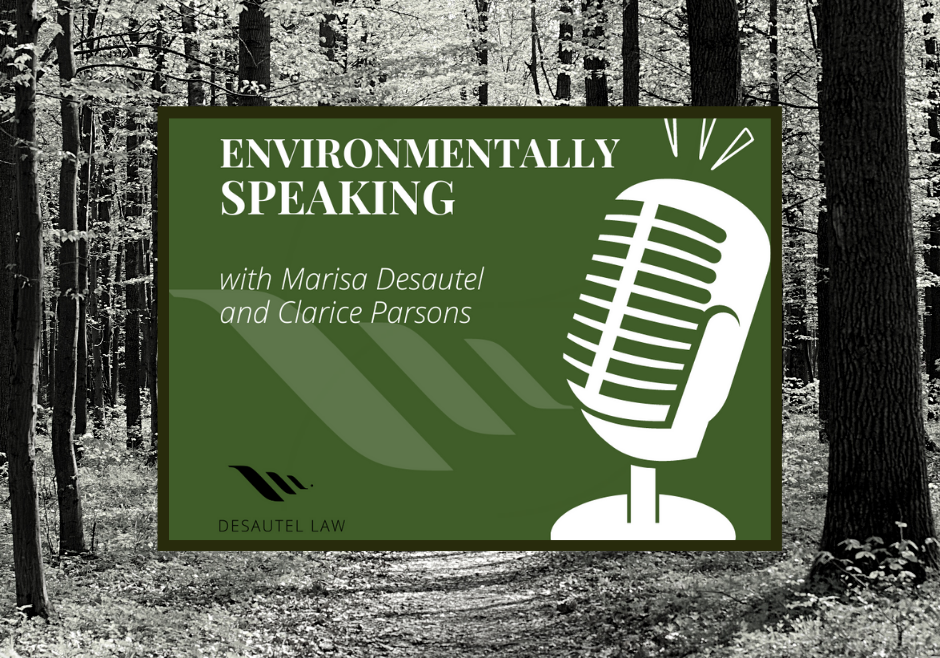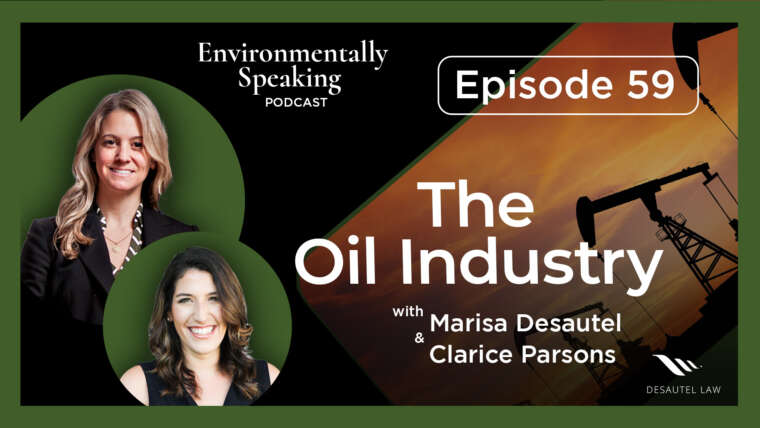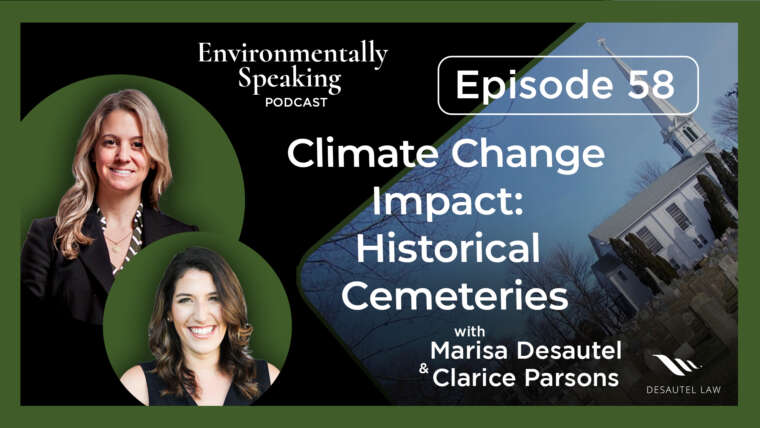This week’s topic might just shock you a little bit, we are going to discuss renewable energy not necessarily being environmentally friendly. WHAT!? This topic was sparked by the Super Bowl commercials that were played this year. There was a clear overarching theme in all of the commercials. Renewable energy for cars. American Capitalism is making a huge push in the market for things like electric cars, but why and what does it take to make this happen? We use an example of what’s going on with the wind farm right off the coast of Rhode Island. We are going to share what’s really going on!
EP 25: Renewable Energy
CLARICE: All right. Good morning, everybody. This is Environmentally Speaking.
MARISA: Happy Valentine’s Day, Clarice. I am Marisa Desautel in case you didn’t know. This is Environmentally Speaking. I’m an environmental attorney with a few decades of experience.
CLARICE: Oh, happy Valentine’s Day. I forgot. I’m Clarice. I am coming at you with your questions, comments, and topics for discussion. And we are just coming off of doing Story Walking Radio Hour with Wendy, so that was a great experience. Shout-out to her. That episode should already be posted on our end. And now we’re back to our original content, what we do every week. What are we talking about this week?
MARISA: Well, to start I think we have to immediately point out the Superbowl halftime show that occurred –
CLARICE: Yes.
MARISA: — last night and how great it was to see some of the artists from my high school days. That dates me a little bit but whatever. And to see people performing without masks was pretty awesome.
CLARICE: Yeah. It was a good show. I was so happy about it. I can’t remember another show that I had liked as much as this one, so.
MARISA: Yeah. It was great.
CLARICE: And keeping with the Superbowl theme –
MARISA: Yes.
CLARICE: — we had talked a little bit about the commercials and that inspired our topic.
MARISA: I was just about to say I have no idea how the Superbowl halftime show is going to dovetail into our topic, but then you just pointed out the entire thought process behind our conversation. I completely forgot.
CLARICE: Only reason why I’m here.
MARISA: Oh, yeah. The Superbowl commercials were, geez, I don’t know, 25 percent about electric vehicles, charging stations, the wave of new automobiles coming onto the market, all had to do with renewable energy and getting away from your traditional gasoline-powered automobiles.
CLARICE: Yeah. I think that was the clear overarching theme in all of the commercials. I think, like you said, it was 25 percent renewable energy for cars and then 100 percent random celebrities holding random products.
MARISA: Yes. Yeah. Doritos with weird Disney animals.
CLARICE: Oh, I didn’t like that one.
MARISA: No.
CLARICE: We’ll hang onto the cars.
[0:02:33] MARISA: Yeah. We’ll hang onto the cars. The renewable energy angle is not new, but I’ll tell you it’s new to American capitalism in the sense that we’re now seeing the market push things like electric cars. Whereas before as is typical of human behavior folks are happy to kick the can down the road in terms of climate change and CO2 emissions and global warming. So it was interesting to me to see the change in structure of what companies are interested in spending their money on in terms of Superbowl advertising. And it also led me to start rethinking about whether the marketing that we’re seeing is entirely appropriate.
CLARICE: Tell me more about that last part.
MARISA: Say that again.
CLARICE: I said, tell me more about that last part.
MARISA: I know, right.
CLARICE: That sounded cheeky. I liked it.
MARISA: Yeah. So I get this – this topic comes up fairly often and people are generally surprised that I have this attitude of not immediately embracing all renewable energy and there’s a reason for that. It’s because in my experience as an environmental attorney what American companies are marketing as renewable energy and responsible stewardship of the environment is not necessarily that. We’ve got right off the coast of Rhode Island a project that went online not long ago off of the coast of Block Island. It’s called the Block Island Wind Farm.
And if you’ve been following the news at all lately, you know that those wind turbines have failed and the cable that connects the turbines to the substation on Block Island recently became unburied and required the project developer to go in and do some reconstruction and maintenance and undertook activities that are not good for the environment. So I fear that we’re being fed this line that’s not factually accurate where just because a project is labeled renewable energy people need to understand that it’s not necessarily good for the environment. The green economy, so-called, and environmental conservation and stewardship do not go hand in hand necessarily.
[0:05:32] CLARICE: Yeah. Sometimes it can be – sometimes things are labeled as renewable energy simply because we’re kind of moving away from coal and fossil fuel, but, you know, there are still other effects. There are still – where are we pulling this energy from. What does the aftermath look like once we’ve, you know, sucked that energy out. How much energy is spent converting it from raw to usable. There’s tons of questions that can be really overwhelming and kind of disheartening because a lot of times you’re thinking this is going to be a great idea, this is going to be such a good forward-focused project and then, you know, you’ve got problems like Block Island which, you know, obviously it was never the – I don’t want to sit here and say there was an intent to have the line become unburied, but it can cause big problems down the road.
MARISA: Yes. Agreed. I don’t think it’s anyone’s intent to have a project fail, but that leads to an important point that a lot of the technology is untested in the United States anyway. These offshore wind projects are slated for areas outside of what’s known as state territorial waters. The leases for these projects are located in federal waters, so it’s the federal government that as oversight and authority over these lease areas for wind farms.
But the technology and the oversight and the construction impacts are, in my opinion and based on my experience, not fully vetted. And these projects, we’re seeing them move forward at lightning speed. In the environmental world everything takes forever if you’re talking about remediation or permitting. It takes time either because the science takes time or the regulator takes time. Things need to be reviewed, looked at, analyzed. And in the case of offshore wind, we’re not seeing that happen. So it’s concerning if you’re an environmentalist to see projects move forward without the full analysis of what project impacts are going to be.
CLARICE: Earlier when we were setting up for today’s recording and prepping you had also said that you wanted to mention there was a federal act, too, that was being discussed kind of related to renewable energy. And I’m not quite sure if it’s connected more towards electric cars or just renewable energy as a whole.
[0:08:24] MARISA: Renewable energy, yes.
CLARICE: Okay.
MARISA: Electric cars, not so much.
CLARICE: Okay.
MARISA: Thanks for the reminder. The federal statute that we were talking about is called the National Environmental Policy Act or NEPA for short because we love acronyms.
CLARICE: [inaudible].
MARISA: Yeah. It’s a federal law that went into effect in 1970 and it was meant to target federal agencies that were undertaking activities which affected the quality of the environment. Prior to NEPA federal agencies were marching forward with projects and activities without considering any of the impacts of these activities on the environment. A really good example of that that I learned in law school was let’s take the Federal Highway Administration. Prior to NEPA they would, I guess, look at a map and say, okay, we have to construct a highway from point A to point B. What’s the shortest route.
It makes sense if you’re not considering the environment. However, if you are considering the environment and the shortest route from point A to point B goes directly through a freshwater wetland or habitat meant for endangered species it’s not a good idea to build the highway that way. So when NEPA was enacted, a federal agency like the Highway Administration had to take a step back and say, okay, we can’t do things the way that we’ve been doing them. We need to undertake a new analysist. And that new analysis was called either an environmental assessment or an environmental impact statement.
These are reports that the federal agency puts together that goes through what the potential environmental effects are and has to make a decision about which alternative it wants to move forward with. Whether NEPA actually has teeth is a different matter, but the intent of the statute was to make federal agencies take a step back and look at what their projects were doing. And it’s not every project. It’s not every federal project. you know, if you work for the Library of Congress you don’t need to do an environmental assessment if you’re ordering a box of paper. But if you’re undertaking a major federal action that’s likely to affect human health or the environment, then you have to put together a report about the environment impacts.
CLARICE: Now, you brought an interesting point out about whether or not it has teeth, which, you know, as we all know everything – like things sound really awesome on paper, but enforceability is when we really start to get the action. Do you know offhand if Rhode Island has a state version of this that might be more enforceable or have a little bit more bite to it?
[0:11:34] MARISA: No. Because this particular statute is directed at only federal agencies. It’s not directed at state agencies.
CLARICE: That’s the good news we deliver on this podcast. There it is for you. Why do I ask. I try to ask these helpful questions.
MARISA: Well, you know I’m negative so stepping into it every time.
CLARICE: I try to have some hope. But, I mean, there is some small comfort in knowing that there’s something out there and it’s not like the days of Mad Men. And I always think of if any of our viewers or listeners ever watched Mad Men there was a scene in the early season where Don Draper and his family go out for a picnic and it’s set in the ‘50s. And once the picnic is done they shake the blanket and all the trash goes everywhere. And they’re like, okay, back in the car. So, I mean, it’s at least on our radar now. Is it being on our radar enough, no. We need to do more than just be mindful of it. We need to start putting in some practice, but.
MARISA: Agreed.
CLARICE: This is the first step.
MARISA: Well, it’s also a fairly old statute and it has been subject to review and revision, sure. But more concerningly for me is the fact that you’ve got this federal statute in place that’s supposed to require federal agencies to slow down and look at environmental impacts, but with these offshore wind farms where is NEPA.
CLARICE: It’s not happening.
MARISA: Where is the substantive public input and review process where people can be made aware of what’s actually happening with these wind farms. And it’s just not – it’s not available for public consumption. And the wind farms are flying forward, so it’s just something to think about. Renewable energy is not necessarily environmentally friendly.
CLARICE: And for some of our listeners who aren’t in the Rhode Island or southern Mass area, if you haven’t read up on these projects Rhode Island has – there’s a ton of open wind farm projects and there’s a lot of discussion. It’s kind of a new hot topic in Rhode Island. So if you haven’t had a chance to read up on it at all, I would encourage you, you know, Google an article or two just to get a baseline. I think on Desautel the website there are a couple blog posts about the effects of this and some status updates to the project. So it’s an interesting read. You can read it on your lunch hour. You can feel a little bit more informed. You can say you did something other than scrolling Twitter, so there’s a benefit.
[0:14:09] MARISA: Yeah.
CLARICE: So I almost want to make a parallel to diet culture. Not everything that’s labeled as healthy is actually healthy for you. And not everything that’s a renewable resource or a renewable energy is going to be the best thing for the environment. And, you know, I kind of feel like as always you got to do a little bit of research. You have to see for yourself. Is this a good fit. Is this going to be a good decision.
MARISA: It’s a good parallel.
CLARICE: So uplifting. Well, on that note that’s your daily dose of narcissism – or not narcissism.
MARISA: Narcissism?
CLARICE: Oh, I meant to say –
MARISA: Pessimism?
CLARICE: — pessimism, but then narcissist came out.
MARISA: We’re doing good.
CLARICE: We haven’t recorded in like two weeks. I miss you guys.
MARISA: All right. That’s all I have.
CLARICE: All righty. So if you have any questions, thoughts, comments, if you want to correct me or come at me for narcissism versus pessimism, go for it. We’d love to interact with you guys. You can reach out on our Instagram. You can head over to our website. And on that note try to have a good Monday or whatever day.
MARISA: Bye.




